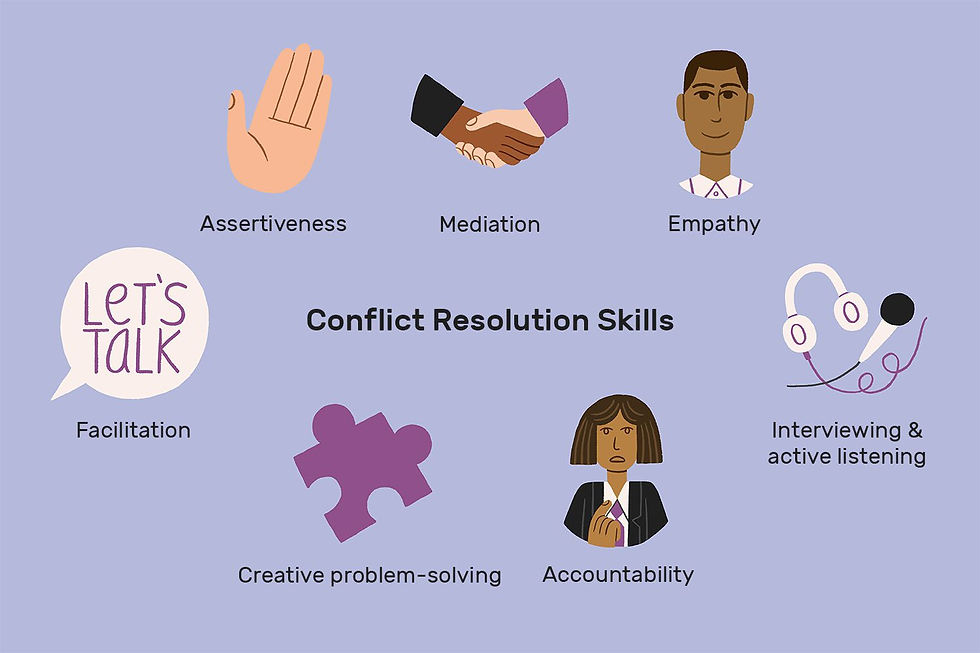Resolving Misinterpreted Messages in Virtual Project Teams
- Bhavana Tadiboina
- Dec 20, 2024
- 3 min read
In today's digital-first workplace, virtual project teams are more common than ever. While technology enables seamless collaboration across borders, it also introduces new challenges, particularly the risk of misinterpreted messages. A misunderstood email or an unclear chat message can quickly escalate into conflict, derailing project progress. However, with the right strategies, you can effectively address and resolve these conflicts, ensuring your team remains cohesive and productive.

The Root Cause of Misunderstandings
Virtual teams often rely heavily on text-based communication, which lacks the tone, context, and non-verbal cues of face-to-face interactions. Additionally, cultural differences, language barriers, and varying interpretations of tone or intent can exacerbate misunderstandings. Recognizing these pitfalls is the first step to resolving and preventing conflicts.

Effective Conflict Resolution Strategies
Clarify Intentions Promptly
When a message is misinterpreted, address the issue quickly. Seek clarification or restate your intentions to ensure everyone is aligned. Avoid assumptions and approach the situation with curiosity rather than judgment.
Use Video Calls for Complex Discussions
Video conferencing adds a personal touch and enables team members to pick up on non-verbal cues, such as facial expressions and tone of voice. It’s a powerful tool for resolving sensitive matters.
Establish Clear Communication Norms
Set ground rules for communication, such as response times, preferred tools, and expectations for tone. Encourage team members to summarize key points to confirm shared understanding.
Encourage Active Listening
Active listening fosters empathy and understanding. During discussions, let each party explain their perspective without interruption. Reflect on what’s being said to demonstrate comprehension.
Leverage Collaborative Tools
Tools like Asana, Trello, or Slack can help maintain task transparency and alignment. Shared dashboards and documented updates reduce ambiguity and keep everyone on the same page.
Foster an Open and Respectful Culture
Create an environment where team members feel comfortable voicing concerns. A culture of mutual respect and psychological safety ensures constructive dialogues even during conflicts.
Provide Conflict Resolution Training
Equip your team with the skills to navigate disagreements effectively. Workshops or role-playing exercises can enhance communication and mediation skills.
Address Issues Early and Follow Up
Nip conflicts in the bud before they escalate. Once resolved, follow up to ensure the resolution is effective and to prevent recurrence.
A Real-Life Example
At BeeHive Media, we encountered a conflict during a virtual campaign collaboration. Misinterpreted feedback on deliverables caused delays and tension among team members. Recognizing the issue, we quickly organized a video call to clarify expectations and realign goals. By addressing the misunderstanding promptly, we not only resolved the conflict but also strengthened team synergy and trust. This experience reinforced the importance of clear communication and proactive conflict management.
Preventing Future Misunderstandings
Prevention is better than cure. To avoid misinterpretations, consider the following:
Assign Clear Roles and Responsibilities: Ensure everyone knows their tasks and objectives.
Appoint a Moderator for Meetings: A moderator can keep discussions focused and ensure all voices are heard.
Document Decisions and Actions: Maintain records of meetings and agreements to avoid future discrepancies.
Rotate Between Virtual and In-Person Meetings: When feasible, occasional face-to-face meetings can enhance rapport and understanding.
Conclusion
Misinterpreted messages in virtual teams can hinder productivity, but they are not insurmountable. By prioritizing clarity, empathy, and proactive communication strategies, you can resolve conflicts effectively and foster a collaborative team environment. Remember, every conflict is an opportunity to strengthen your team’s communication and cohesion. With the right approach, virtual teams can thrive, no matter the distance.



Comments